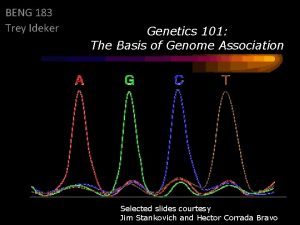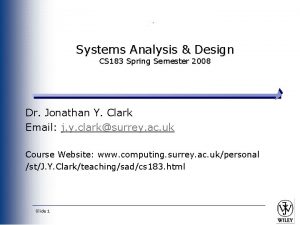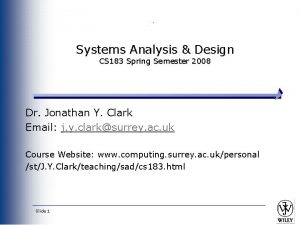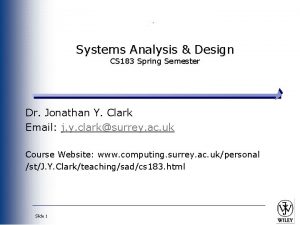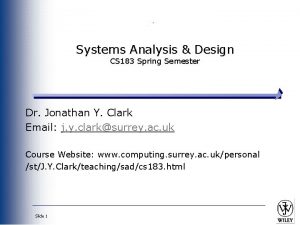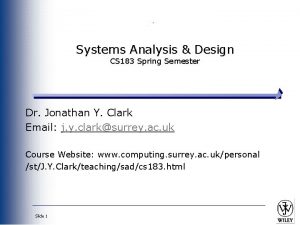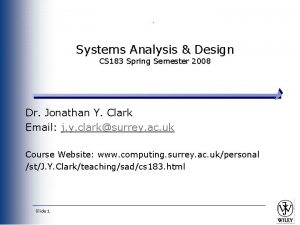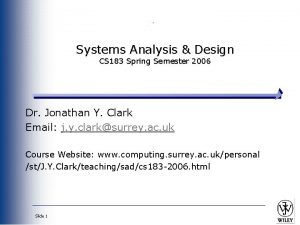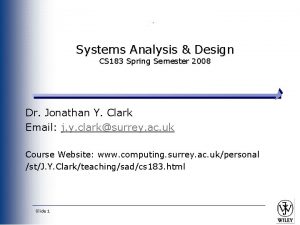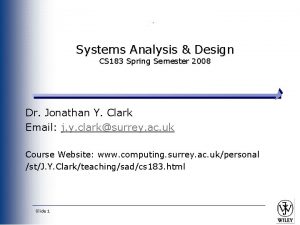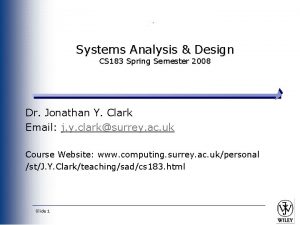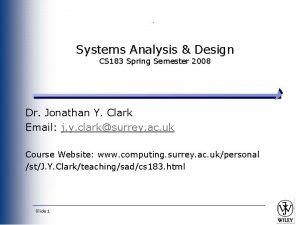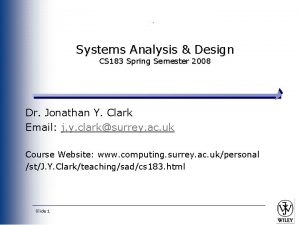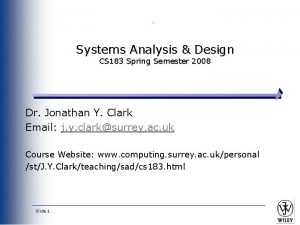Systems Analysis Design CS 183 Jonathan Y Clark





























- Slides: 29

Systems Analysis & Design CS 183 Jonathan Y. Clark 01 AA 03 (level 20) j. y. clark@surrey. ac. uk Lectures Tues 12– 1 Labs Tues Group One 1– 2 or Group Two 5– 6 1 Power. Point Presentation for Dennis & Haley Wixom, Systems Analysis and Design Copyright 2000 © John Wiley & Sons, Inc. All rights reserved.

Systems Analysis and Design Alan Dennis and Barbara Haley Wixom John Wiley & Sons, Inc. Slides by Fred Niederman Slide 2 Power. Point Presentation for Dennis & Haley Wixom, Systems Analysis and Design Copyright 2000 © John Wiley & Sons, Inc. All rights reserved.

Introduction Chapter 1 Slide 3 Power. Point Presentation for Dennis & Haley Wixom, Systems Analysis and Design Copyright 2000 © John Wiley & Sons, Inc. All rights reserved.

Key Ideas Many failed systems were abandoned because analysts tried to build wonderful systems without understanding the organisation. The primary goal is to create value for the organisation. 4 Power. Point Presentation for Dennis & Haley Wixom, Systems Analysis and Design Copyright 2000 © John Wiley & Sons, Inc. All rights reserved.

Key Ideas The systems analyst is a key person analyzing the business, identifying opportunities for improvement, and designing information systems to implement these ideas. It is important to understand develop through practice the skills needed to successfully design and implement new information systems. 5 Power. Point Presentation for Dennis & Haley Wixom, Systems Analysis and Design Copyright 2000 © John Wiley & Sons, Inc. All rights reserved.

THE SYSTEMS DEVELOPMENT LIFE CYCLE Slide 6 Power. Point Presentation for Dennis & Haley Wixom, Systems Analysis and Design Copyright 2000 © John Wiley & Sons, Inc. All rights reserved.

Major Attributes of the Lifecycle The project -Moves systematically through phases where each phase has a standard set of outputs Produces project deliverables Uses deliverables in implementation Results in actual information system Uses gradual refinement 7 Power. Point Presentation for Dennis & Haley Wixom, Systems Analysis and Design Copyright 2000 © John Wiley & Sons, Inc. All rights reserved.

Project Phases Planning (Why build the system? ) Analysis (Who, what when, where will the system be? ) Design (How will the system work? ) Implementation (System delivery) 8 Power. Point Presentation for Dennis & Haley Wixom, Systems Analysis and Design Copyright 2000 © John Wiley & Sons, Inc. All rights reserved.

A “Simple” Process for Making Lunch 9 Power. Point Presentation for Dennis & Haley Wixom, Systems Analysis and Design Copyright 2000 © John Wiley & Sons, Inc. All rights reserved.

Planning Identifying business value Analyze feasibility Develop work plan Staff the project Control and direct project 10 Power. Point Presentation for Dennis & Haley Wixom, Systems Analysis and Design Copyright 2000 © John Wiley & Sons, Inc. All rights reserved.

Analysis Information gathering Process modeling Data modeling 11 Power. Point Presentation for Dennis & Haley Wixom, Systems Analysis and Design Copyright 2000 © John Wiley & Sons, Inc. All rights reserved.

Design Physical design Architectural design Interface design Database and file design Program design 12 Power. Point Presentation for Dennis & Haley Wixom, Systems Analysis and Design Copyright 2000 © John Wiley & Sons, Inc. All rights reserved.

Implementation Construction Installation 13 Power. Point Presentation for Dennis & Haley Wixom, Systems Analysis and Design Copyright 2000 © John Wiley & Sons, Inc. All rights reserved.

Processes and Deliverables Process Product Planning Project Plan Analysis System Proposal Design System Specification Implementation 14 New System and Maintenance Plan Power. Point Presentation for Dennis & Haley Wixom, Systems Analysis and Design Copyright 2000 © John Wiley & Sons, Inc. All rights reserved.

SYSTEM DEVELOPMENT METHODOLOGIES Slide 15 Power. Point Presentation for Dennis & Haley Wixom, Systems Analysis and Design Copyright 2000 © John Wiley & Sons, Inc. All rights reserved.

What Is a Methodology? A formalized approach or series of steps Examples Process-Centered Data-Centered Object-Oriented 16 Power. Point Presentation for Dennis & Haley Wixom, Systems Analysis and Design Copyright 2000 © John Wiley & Sons, Inc. All rights reserved.

Waterfall Development Method 17 Power. Point Presentation for Dennis & Haley Wixom, Systems Analysis and Design Copyright 2000 © John Wiley & Sons, Inc. All rights reserved.

Pros and Cons of the Waterfall Method Pros Cons Identifies systems requirements long before programming begins Design must be specified on paper before programming begins Long time between system proposal and delivery of new system 18 Power. Point Presentation for Dennis & Haley Wixom, Systems Analysis and Design Copyright 2000 © John Wiley & Sons, Inc. All rights reserved.

Alternatives to the SDLC Parallel Development Rapid Application Development (RAD) Phased Development Prototyping Spiral Development Packaged Systems 19 Power. Point Presentation for Dennis & Haley Wixom, Systems Analysis and Design Copyright 2000 © John Wiley & Sons, Inc. All rights reserved.

Parallel Development Method 20 Power. Point Presentation for Dennis & Haley Wixom, Systems Analysis and Design Copyright 2000 © John Wiley & Sons, Inc. All rights reserved.

Pros and Cons of Parallel Development Pros 21 Cons Reduces Scheduled Time Still Uses Paper Documents Less Chance of Rework Sub-projects May Be Difficult to Integrate Power. Point Presentation for Dennis & Haley Wixom, Systems Analysis and Design Copyright 2000 © John Wiley & Sons, Inc. All rights reserved.

Rapid Application Development CASE tools JAD sessions Fourth generation/visualization programming languages Code generators 22 Power. Point Presentation for Dennis & Haley Wixom, Systems Analysis and Design Copyright 2000 © John Wiley & Sons, Inc. All rights reserved.

Three RAD Categories Phased development A series of versions Prototyping System prototyping Throw-away prototyping Design prototyping 23 Power. Point Presentation for Dennis & Haley Wixom, Systems Analysis and Design Copyright 2000 © John Wiley & Sons, Inc. All rights reserved.

How Prototyping Works 24 Power. Point Presentation for Dennis & Haley Wixom, Systems Analysis and Design Copyright 2000 © John Wiley & Sons, Inc. All rights reserved.

Throwaway Prototyping 25 Power. Point Presentation for Dennis & Haley Wixom, Systems Analysis and Design Copyright 2000 © John Wiley & Sons, Inc. All rights reserved.

Criteria for Selecting the Appropriate Methodology Clear user requirements Familiar technology Complexity Reliability Time schedule Schedule visibility 26 Power. Point Presentation for Dennis & Haley Wixom, Systems Analysis and Design Copyright 2000 © John Wiley & Sons, Inc. All rights reserved.

TEAM ROLES AND SKILLS Slide 27 Power. Point Presentation for Dennis & Haley Wixom, Systems Analysis and Design Copyright 2000 © John Wiley & Sons, Inc. All rights reserved.

Information Systems Roles Business analyst System analyst Infrastructure analyst Change management analyst Project manager 28 Power. Point Presentation for Dennis & Haley Wixom, Systems Analysis and Design Copyright 2000 © John Wiley & Sons, Inc. All rights reserved.

Summary The Systems Development Lifecycle consists of four stages: Planning, Analysis, Design, and Implementation There are five major development methodologies: the waterfall method, the parallel development method, the phased development method, system prototyping and design (throwaway). prototyping There are five major team roles: business analyst, systems analyst, infrastructure analyst, change management analyst and project manager. 29 Power. Point Presentation for Dennis & Haley Wixom, Systems Analysis and Design Copyright 2000 © John Wiley & Sons, Inc. All rights reserved.
 Functions of marketing by clark and clark
Functions of marketing by clark and clark Jonathan david clark
Jonathan david clark Bermuda on the world map
Bermuda on the world map Convenio 183 oit
Convenio 183 oit Mari sebarkan injil
Mari sebarkan injil Ki kd al qur'an hadits ma
Ki kd al qur'an hadits ma Eecs 183
Eecs 183 Convenção 183 oit
Convenção 183 oit Beng 183
Beng 183 Eecs 183 ia
Eecs 183 ia Eecs 183 lab 8
Eecs 183 lab 8 Eecs 183 project 3
Eecs 183 project 3 Cs183b stanford
Cs183b stanford Mhrs kurum
Mhrs kurum The ron clark story character analysis
The ron clark story character analysis Systems analysis & design in an age of options pdf
Systems analysis & design in an age of options pdf Gantt chart system analysis and design
Gantt chart system analysis and design Systems analysis and design in a changing world
Systems analysis and design in a changing world System analysis and design in a changing world
System analysis and design in a changing world Alan dennis system analysis design
Alan dennis system analysis design Introduction to system analysis and design
Introduction to system analysis and design Major tools of ssadm
Major tools of ssadm Systems analysis and design 5th edition
Systems analysis and design 5th edition Modern systems analysis and design
Modern systems analysis and design Kendall and kendall system analysis and design
Kendall and kendall system analysis and design Alan dennis system analysis design
Alan dennis system analysis design Systems analysis and design alan dennis
Systems analysis and design alan dennis Systems analysis and design alan dennis
Systems analysis and design alan dennis Systems analysis and design alan dennis
Systems analysis and design alan dennis Systems analysis and design alan dennis
Systems analysis and design alan dennis








